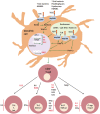Role of toll-like receptors in multiple sclerosis
- PMID: 23885326
- PMCID: PMC3714200
Role of toll-like receptors in multiple sclerosis
Abstract
Multiple Sclerosis (MS) is an autoimmune disease in which Central Nervous System (CNS) lesions result from perivascular immune cell infiltration associated with damage to myelin, oligodendrocytes and neurons. CNS autoimmunity and its regulation are dominated by the inflammatory cytokines IL17 and IFNγ, and the opposing regulatory cytokines IL10 and the type I IFNs. Toll-like receptors (TLR) play a critical role in modulating cytokine and chemokine secretion in response to exogenous Pathogen Associated to Molecular Patterns and endogenous Danger-Associated to Molecular Patterns. Here, we systematically examine the evidence that TLR play a major role in the initiation disease, the triggering of relapses, and regulation of CNS damage. Data from human studies are supported analyses of a variety of animal models, including Experimental Autoimmune Encephalomyelitis in TLR-deficient mice.
Keywords: Multiple sclerosis; TLR1; TLR10; TLR2; TLR3; TLR4; TLR5; TLR6; TLR7; TLR8; TLR9; autoimmunity; gene/environment interactions; hygiene hypothesis; microbial flora; toll-like receptors.
Figures

Similar articles
-
The dysfunctional innate immune response triggered by Toll-like receptor activation is restored by TLR7/TLR8 and TLR9 ligands in cutaneous lichen planus.Br J Dermatol. 2015 Jan;172(1):48-55. doi: 10.1111/bjd.13214. Epub 2014 Nov 20. Br J Dermatol. 2015. PMID: 24976336
-
The Toll-like Receptor 2 (TLR2)-related Immunopathological Responses in the Multiple Sclerosis and Experimental Autoimmune Encephalomyelitis.Iran J Allergy Asthma Immunol. 2019 Jun 8;18(3):230-250. doi: 10.18502/ijaai.v18i3.1117. Iran J Allergy Asthma Immunol. 2019. PMID: 31522431 Review.
-
Expression and function of Toll-like receptors in eosinophils: activation by Toll-like receptor 7 ligand.J Immunol. 2003 Oct 15;171(8):3977-82. doi: 10.4049/jimmunol.171.8.3977. J Immunol. 2003. PMID: 14530316
-
Ligand-regulated chimeric receptor approach reveals distinctive subcellular localization and signaling properties of the Toll-like receptors.J Biol Chem. 2004 Apr 30;279(18):19008-17. doi: 10.1074/jbc.M311618200. Epub 2004 Feb 19. J Biol Chem. 2004. PMID: 14976215
-
Innate immune regulation of autoimmunity in multiple sclerosis: Focus on the role of Toll-like receptor 2.J Neuroimmunol. 2017 Mar 15;304:11-20. doi: 10.1016/j.jneuroim.2016.12.004. Epub 2016 Dec 13. J Neuroimmunol. 2017. PMID: 28007303 Review.
Cited by
-
Associations Between Neuroinflammation-Related Conditions and Alzheimer's Disease: A Study of US Insurance Claims Data.J Alzheimers Dis. 2024;99(2):739-752. doi: 10.3233/JAD-231286. J Alzheimers Dis. 2024. PMID: 38701142 Free PMC article.
-
Alterations of the human gut microbiome in multiple sclerosis.Nat Commun. 2016 Jun 28;7:12015. doi: 10.1038/ncomms12015. Nat Commun. 2016. PMID: 27352007 Free PMC article.
-
Oleanolic Acid Acetate Alleviates Symptoms of Experimental Autoimmune Encephalomyelitis in Mice by Regulating Toll-Like Receptor 2 Signaling.Front Pharmacol. 2020 Sep 3;11:556391. doi: 10.3389/fphar.2020.556391. eCollection 2020. Front Pharmacol. 2020. PMID: 33013394 Free PMC article.
-
Elevated proportion of TLR2- and TLR4-expressing Th17-like cells and activated memory B cells was associated with clinical activity of cerebral cavernous malformations.J Neuroinflammation. 2022 Feb 2;19(1):28. doi: 10.1186/s12974-022-02385-2. J Neuroinflammation. 2022. PMID: 35109870 Free PMC article.
-
Leukemia inhibitory factor inhibits erythropoietin-induced myelin gene expression in oligodendrocytes.Mol Med. 2018 Sep 27;24(1):51. doi: 10.1186/s10020-018-0052-3. Mol Med. 2018. PMID: 30261841 Free PMC article.
References
-
- De Keyser J. Autoimmunity in multiple sclerosis. Neurology. 1988;38:371–374. - PubMed
-
- Brennan KM, Galban-Horcajo F, Rinaldi S, O’Leary CP, Goodyear CS, Kalna G, Arthur A, Elliot C, Barnett S, Linington C, Bennett JL, Owens GP, Willison HJ. Lipid arrays identify myelin-derived lipids and lipid complexes as prominent targets for oligoclonal band antibodies in multiple sclerosis. J Neuroimmunol. 2011;238:87–95. - PMC - PubMed
-
- Allegretta M, Nicklas JA, Sriram S, Albertini RJ. T cells responsive to myelin basic protein in patients with multiple sclerosis. Science. 1990;247:718–721. - PubMed
-
- Miller DM, Weinstock-Guttman B, Bethoux F, Lee JC, Beck G, Block V, Durelli L, LaMantia L, Barnes D, Sellebjerg F, Rudick RA. A meta-analysis of methylprednisolone in recovery from multiple sclerosis exacerbations. Mult Scler. 2000;6:267–273. - PubMed
LinkOut - more resources
Full Text Sources
Other Literature Sources
Miscellaneous
